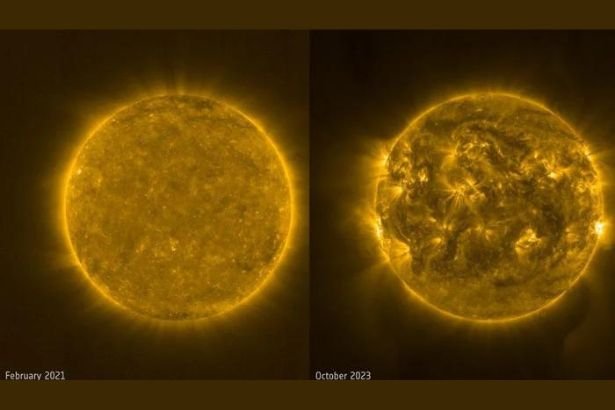ESA Captures Tumultuous Transformation of Sun Approaching Solar Max
The European Space Agency recently released a vivid visualization depicting the escalating turbulence on the surface of the sun leading up to the impending solar maximum in 2024. Captured by ESA’s Solar Orbiter spacecraft, the images illustrate brilliant eruptions and sunspots signaling the sun’s cyclical peak in magnetic activity that can impact life on Earth.
Introducing the Solar Cycle
The sun operates on an 11-year solar cycle between periods of high and low intensity. At the solar maximum, which scientists predict will occur in 2024, the highest levels of solar flares, sunspots, and coronal mass ejections transpire. As the sun progresses through its natural cycle, its magnetic field grows more intense and unstable, fueling increased tumultuous activity.
The solar minimum represents the opposite calm end of the spectrum with minimal sunspot activity and solar flares. After the furor of solar max, the poles switch and the sun proceeds into its minimum inactive phase before intensity builds again.
Harnessing Solar Orbiter’s Vivid Imagery
The ESA/NASA Solar Orbiter probe was launched in 2020 to study the sun’s heliosphere and better understand the solar cycle. As the first images from Orbiter reveal, the current solar cycle 25 is ramping up vigor quickly as mid-2024 approaches.
By meticulously stitching together extreme ultraviolet photos, ESA created a compelling time-lapse visualization of the sun’s turbulence escalating drastically from February 2021 to October 2023.
Brilliant explosions of hot plasma, dark sunspots, and swirling electromagnetic loops dominate Orbiter’s imagery as the sun exhibits skyrocketing activity. Comparing the first calm days of Orbiter’s mission to today illustrates the imminent approach of the solar hurricane.
Impacts of Upcoming Solar Max Activity
While the height of solar cycle chaos still lies ahead in 2024, the sun’s already elevated activity has demonstrated tangible impacts even now. As magnetic fields become more unstable, increased solar storms and flares threaten radio communications blackouts, global navigation systems like GPS, satellites, and even power grids.
During intense solar cycles, wonderful auroras also illuminate polar region skies. But solar tempests can equally damage spacecraft electronics and endanger astronauts. So far, cycle 25 appears to show energy levels exceeding recent past cycles, making advance forecasting critical.
Predicting Future Cycles
Monitoring tools like ESA’s Solar Orbiter are vital for predicting future solar cycle patterns more accurately. While the maximum’s arrival hinges on observing a subsequent drop-off in sunspot numbers, improved long-term solar forecasts help governments and industries bolster infrastructure protections.
By tracking the relationship between the sun’s shifting magnetic fields and eruption activity, scientists improve prediction models continually. Orbiter’s detailed imagery of tumult leading up to the 2024 peak should provide invaluable up-close insight toward forecasting subsequent cycles too.
As Solar Orbiter captures the star in unmatched resolution, expect further revelations about the inner mechanics of space weather and the solar ecosystem powering life here on Earth. The vivid glimpses of the upcoming solar maximum only seem to preview greater discoveries ahead.






